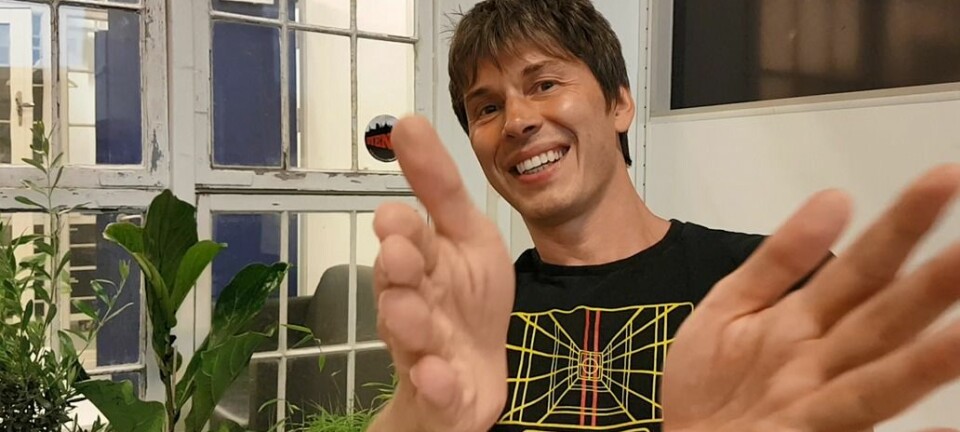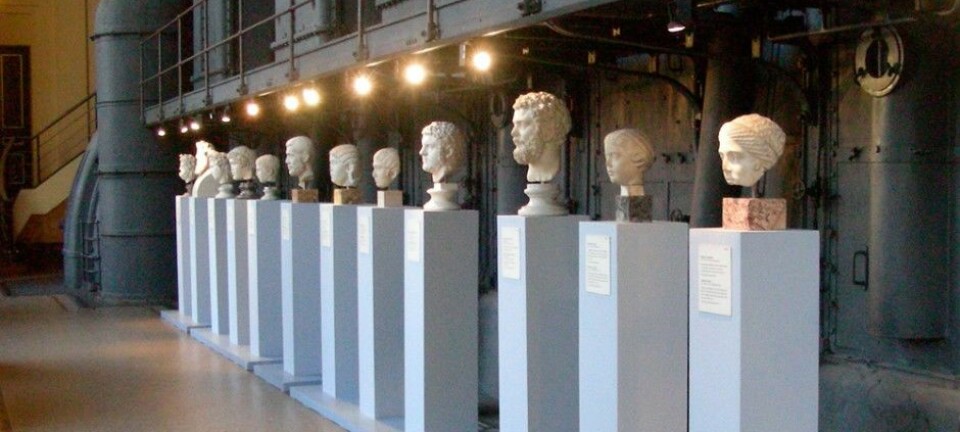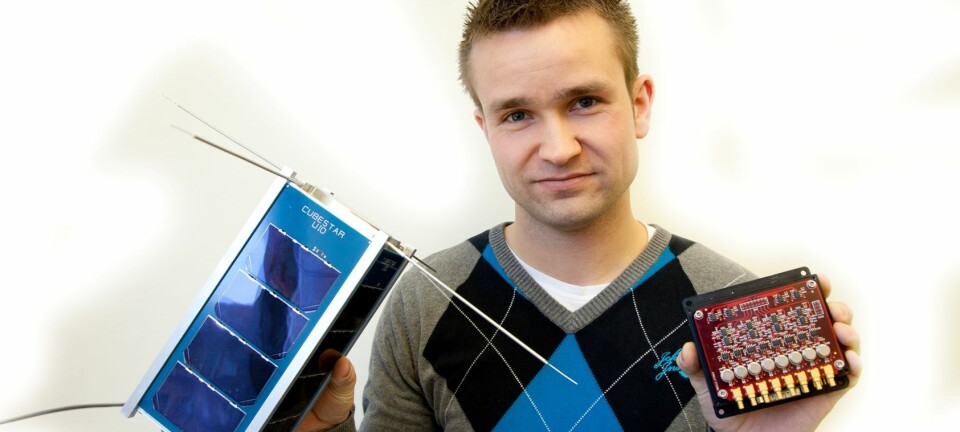
The Big Bang – an eyewitness account
What did the Big Bang actually look like? Join astrophysicist Peter Laursen and his travel companion ‘Alice’ as they explore the beginnings of the Universe.
Once upon a time, almost 14 billion years ago, a spectacular event took place.
The Universe and everything it contains, including matter, radiation, exotic particles, and maybe even more abstract concepts such as time and physical laws, came into existence.
By studying how the Universe has evolved through time, it is possible to “calculate backwards” and form a picture of the physical conditions one billion years, a thousand years, a day, a second, or a nanosecond after the Big Bang. The further back in time, the more extreme the conditions were, and the faster the Universe evolved.
But it is one thing to understand the equations that describe the temperature, or the creation of new particles, or something else. How would it feel to actually witness it? What would it look like? What would you experience?
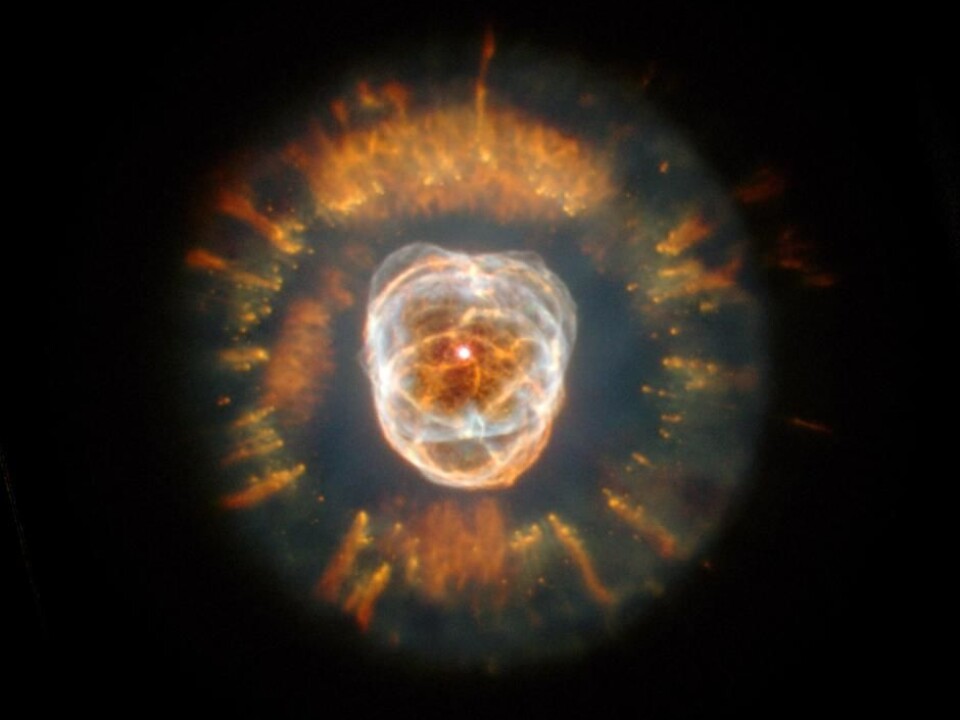
Let’s find out! We must first equip our observer — let’s call her Alice, as I am currently listening to the song “Alice” by Tom Waits, and since it is a popular name for victims of thought experiments —with a Magical Space SuitTM, able to withstand extreme heat, pressure, density, radiation, and stretch. She will also need a pair of sunglasses, because until the Universe was a million years old it was dazzlingly bright.
You can follow Alice’s journey in the interactive graphic below. But before we set off, we need to establish a few things.
Interactive: Click to explore the colour of the Universe from the Big Bang to today. If viewing on a phone you may wish to rotate your screen and enlarge to view. Alternatively click to view in a new browser tab, and rotate your phone to view in full screen. (Graphic: ScienceNordic)
How do we know what happened?

Because light does not travel infinitely fast, we see everything as it was in the past. When you check your phone, you look a nanosecond back in time, since that is how long it took the light particles to travel 30 centimetres. When you look at the Moon, you look a good second back in time, because the Moon is 400,000 kilometres away. And when you observe a galaxy a billion lightyears away, you are actually looking a billion years back in time.
We can measure the density, temperature, and other physical quantities of the Universe. Observing the velocity of galaxies tell us that the Universe is expanding. If we calculate backwards, we can work out the physical conditions in earlier epochs.
In this way, we are actually pretty certain about what happened all the way back to less than a second after the Big Bang. This is because we can not only calculate, but also perform experiments in huge particle accelerators such as CERN, to recreate the conditions that prevailed at that time, and confirm that we’re not completely wrong.
But we don’t know anything about the very first fraction of a fraction of a second — the so-called “Planck Epoch.” At this time, the conditions were so extreme that physical laws break down. Perhaps it does not even make sense to talk about space and time at this point in the Universe’s history.
How big is the Universe?
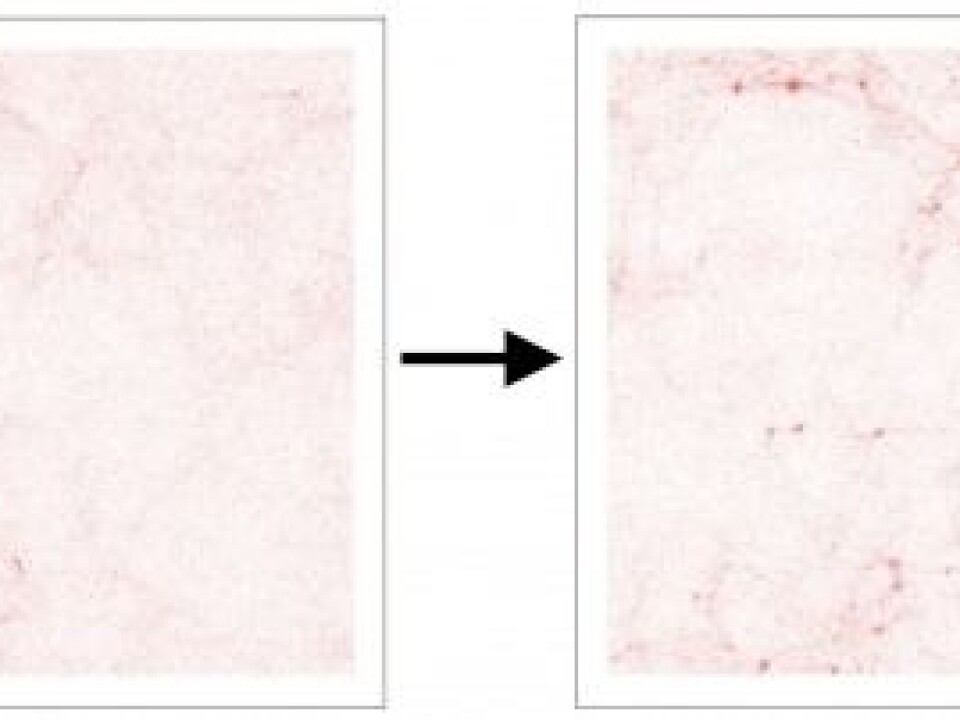
Read More: Cosmic dust changes our understanding of the birth of the universe
Infinite… Maybe…
We don’t know how big the Universe is. We can only see the part of it from which light has had the time to reach us. This part is called “the observable Universe,” and because the Universe is 13.8 billion years old, you might think that we can look 13.8 lightyears in all directions. But because it expands, it is somewhat bigger, in fact a good 46 billion lightyears.
We assume, though we are not certain, that the Universe outside our little bubble goes on forever. If that is true, then it was “born” infinitely large. Although it actually makes physical sense to talk about an infinitely large Universe that grows or shrinks, it is undoubtedly hard to visualise. So we normally consider the size of the observable Universe instead.
It is important to know that, no matter the size of the Universe, the Big Bang was not an “explosion” in the sense that a dense clump of matter started spreading out through space. Rather, it was the creation of space, and perhaps time itself, and the subsequent expansion of this space.
This begs the question, “what does it expand in?” and “what’s outside?” It’s hard to imagine an infinite Universe expanding, let alone a finite Universe that is not embedded in some larger dimensional space.But nonetheless, that is what we think is happening. In other words, it is simply expanding “in itself.”
Now, with ‘Cosmology 101’ out of the way, let’s re-join Alice as she starts her journey.
Inflation in the dark
As mentioned above, we don’t know anything about the very first split second. We know, however, that everything was extremely dense, because what will later become our observable Universe is at this time smaller than an atomic nucleus.
First, gravity is created, and then the “strong” nuclear force. Some exotic particles precipitate from this extreme energy density, including the Higgs boson, which is responsible for the very concept of mass.
But at first, Alice does not appreciate any of this inferno. Light has not yet been created, so to her, everything is dark.
Suddenly, space itself begins to expand exponentially fast.
This era is called “inflation,” and when it comes to a halt, what will later become the observable Universe has, in a split second, grown from being smaller than an atomic nucleus to 20 metres in diameter. It is still only the size of a house, but relatively speaking the Universe has grown as much during this fraction of a second as it has ever since.
Whatever is in space must follow the expansion. Except Alice’s magic space suit of course, and what luck, because without it her head and her feet, which at this time are much bigger than the observable Universe, would be torn 20 billion lightyears apart!
After inflation, everything continues to expand. At the same time, the temperature drops. It is like when the gas from an unlit lighter feels cold: The gas is compressed inside the lighter but when it escapes, it expands and cools.
Read More: How do scientists find new planets?
…and there was light
During inflation, the Universe briefly supercools from a billion billion billion degrees, to almost absolute zero. But when inflation is over, just as Alice thinks “Brrr… maybe it’s getting a bit too cold”, the so-called reheating process increase the temperature again to 10 billion trillion degrees. At this time, new species of particles are created, including light in the form of photons.
Because the temperature is so incredibly high, all particles are very energy-rich, and the vast majority of photons are therefore gamma rays. But a small part of the light spectrum extends over x-rays, ultraviolet light, and visible light, which is of most interest to Alice.
So, what is the first colour that Alice observes? What was the colour of Big Bang?
The term "colour" is in fact a psychological concept. The colour that the brain perceives depends on the distribution of light in the three wavelength ranges sensed by the cones of the eyes, namely red, green, and blue.
If something emits light because it is hot, you can calculate its spectrum and subsequently work out its colour in red, green, and blue. Alice herself is not so warm, so she mostly emits in the energy-weak infrared light, and a human eye is not sensitive enough to perceive the tiny part of it that sits in the visible spectrum.
A piece of hot, incandescent iron emits mostly in the red. If it gets really hot, it emits roughly equally in both red, green, and blue, and that is interpreted by the brain as “white light”.
If the temperature is sufficiently high, the spectrum peaks in the blue, and in the limit of an infinite temperature, the colour approaches a sapphire-blue hue.
Thus, what Alice sees around her is the sapphire-blue of this hot quark-gluon plasma soup, as shown in the image below.
Alice's space suit is of course equipped with an electronic colour meter, and she measures the colour saturation of the Universe to be 63 per cent, 71 per cent, and 100 per cent in red, green, and blue, respectively.
That is, she would if it had worked, but the Universe is still only 1/100 of a millionth of a trillionth of a trillionth of a second old, and electricity does not yet exist.
Alice must wait a full picosecond (0.000000000001 seconds) before the electromagnetic force is created. That might not sound like a long wait, but as with everything in space and time, it is all relative! For Alice, this additional wait time is equal to a hundred quintillions times longer than her entire journey time so far.
Alice gains weight
At this time, the “weak” force is also created. This means that all four forces of the Universe are now established, the other three being the electromagnetic force, gravity, and the “strong” force.
Strictly speaking, all of these forces existed already, but they were merged as one single unified force until they began separating into their “individual” forces.
With these four forces in place, particles can now interact with the Higgs boson and hence gain mass.For Alice, this means that she now weighs something. But since perverted fashion standards will not exist for another 13.8 billion years, she is not so bothered about this sudden weight gain.
Read More: What's the (dark) matter?
Lumps in the soup
Alice's surroundings are pretty boring; everything is completely evenly distributed, so no matter where she looks, she sees the same thing.
But wait… tiny irregularities are formed by the quantum mechanical uncertainty principle, which says that there is a fundamental lower limit, in terms of how exact it makes sense to be when talking about the position of an object.
Quantum mechanics describe processes on very small scales, from the size of atoms and below. But because of the extreme expansion, the small inhomogeneities are pumped up to sizable proportions.
And what luck! Had everything been completely smooth, it would forever remain so. But instead, there exist ever-so-small lumps that weigh a tiny bit more than their surroundings and can therefore pull on a little more matter. This allows them to grow and eventually form the structure in the Universe that turns into galaxies, stars, planets, and ultimately, us.
Dark matter to the rescue
But is matter able to clump sufficiently, before expansion pulls it too far apart? (Spoiler alert: Yes, or else you would not be reading this!)
Actually, if the only matter that existed was the stuff that Alice can see, then this could not happen. But luckily, for every gram of matter there are roughly five grams of some other, invisible matter that provides the additional gravity needed to let matter clump together. We call this, dark matter.
The Universe has now cooled to 10 million billion degrees and is roughly as large as the distance from the Earth to the Sun today. The clump that will one day turn into the Milky Way is 100 kilometres in radius, roughly the size of Sierra Leone.
Read More: Q&A: Professor Brian Cox talks scicomm
The Universe slows down
The Universe keeps expanding because of the speed it acquired by inflation, but the expansion rate slowly decelerates due to the mutual attraction of all particles.
However, even a full nanosecond after the Big Bang, expansion is so rapid that objects more than a metre away from Alice, are moving away from her faster than the speed of light. Just a microsecond later, it is cold enough that quarks have merged to form neutrons and protons.
The Universe is now the size of the Solar System, but the density of matter and radiation is still 1,000 times higher than a neutron star, the most compact thing that exists today.
Evil twins
Alice now sees not only particles, but also antiparticles coming into existence.
An antiparticle is like the particle’s evil twin, and if a particle meets its antiparticle they both cease to exist and new particles are created. Some of these new particles are photons — light.
For reasons that we do not yet understand, for every 10 billion antiparticles that existed there were 10 billion and one particle, give or take.
At a grand old age of one second, the Universe has now swelled to 10 lightyears in radius, and all antiprotons have annihilated with protons, antineutrons with neutrons, and so on. The tiny surplus of "normal" particles is what today comprises the visible cosmos.
Read More: Gravitational-wave astronomy will change our understanding of the universe
Warm and bright, with a risk of fog
Another ten seconds goes by and electrons and antielectrons are up! The Universe has now cooled to a few billion degrees, but since 99.99999999 per cent of all particles are converted to pure light, the Universe suddenly blazes with a dazzling light.
In the beginning of this particle-eats-particle inferno, the density is so high that Alice literally cannot see a hand in front of her face as light is constantly scattered by the electrons.
But when all of a sudden the majority of the electrons disappear into the (sapphire) blue, the visibility increases to… drum roll please… how large can it be? A gazillion lightyears?! Ah, no, 20 metres. Not very impressive! But it doesn’t really matter since there is not that much to see yet anyway: Behind the misty veil it is, well, just more of the same.
After a few minutes, the temperature has fallen below a billion degrees, and an important epoch in the history of the Universe kicks in — nucleosynthesis. It is now cold enough that protons, which are in fact the same as hydrogen, fuse to form heavier elements.
Alas, happiness is short-lived: The density of the Universe is decreasing due to expansion, and at 15-minutes-old, it has about the same density as water on Earth. Nucleosynthesis is coming to an end.
So far, only helium and a little bit of lithium have had time to form. All the heavier atoms will not be formed for hundreds of millions of years, in stars and their death explosions.
Bibbidi-Bobbidi-Boo! And the Big Bang is through!
That's it, folks. After just a quarter of an hour, the Big Bang is over, and now nothing much happens for thousands of years.
Every time a neutral atom tries to form, the electron is immediately torn off by a highly energetic photon. But at 380,000-years-old, the temperature of the Universe has fallen to 3,000 degrees, has acquired a nice orange-red tint, and is cold enough that hydrogen atoms may remain neutral.
Consequently, the foggy electron veil is lifted and light escapes – decouples – from matter.
The afterglow of the Big Bang
The Universe is now almost a million lightyears in diameter, and light streams freely through the entire Universe, as it has done ever since.
The lumps of matter that Alice saw form have grown bigger, but are at the time of decoupling still very small; the densest regions are 1/100,000 times denser than the most dilute regions. Nevertheless, this is enough for the radiation that is released to not exhibit the same wavelength everywhere.
And this light — the slightly irregular afterglow of Big Bang, known as "the cosmic microwave background" — is now the most distant thing we are able to see. Much of what we know about Big Bang, and of the Universe in general, we have gleaned from studying this light.
Read More: Scientist: We could find intelligent life in space within two decades
Big Bang timeline (and the history of the Universe)
Alice has had the time of her life and can now put her space suit and sunglasses back on the shelf.
If in the meantime you have lost track of space and time, you'll find an extended graphical timeline of the Big Bang (and the rest of the history of the Universe) here.
While writing this article I've written a code called timeline which computes the properties (size, temperature, colour, expansion rate, and more) of the Universe at various times in its history. The code is written in the language Python, and may be retrieved here.
Or check out our interactive graphic above.
---------------
Read this article in Danish at ForskerZonen, part of Videnskab.dk
Translated by: Peter Laursen
